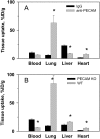Targeted detoxification of selected reactive oxygen species in the vascular endothelium
- PMID: 19692634
- PMCID: PMC2775262
- DOI: 10.1124/jpet.109.156877
Targeted detoxification of selected reactive oxygen species in the vascular endothelium
Abstract
Oxidative stress underlies diverse vascular diseases, but its management remains elusive, in part because of our inability to selectively detoxify reactive oxygen species (ROS) in pathological sites and our limited understanding which species need to be eliminated. The antioxidant enzymes (AOEs) superoxide dismutase (SOD) and catalase (which decompose and H(2)O(2), respectively), conjugated with an antibody to platelet-endothelial cell adhesion molecule-1 (PECAM-1), bind to endothelial cells and alleviate oxidative stress in cell culture models. Here, we studied the effects of these antioxidant conjugates in mouse models of vascular oxidative stress. Anti-PECAM/catalase and anti-PECAM/SOD conjugates, in contrast to control IgG/AOE conjugates, accumulated in the lungs and vascularized organs after intravenous injection in wild-type, but not PECAM KO mice. Anti-PECAM/catalase, but not anti-PECAM/SOD, protected mice from lung injury induced by H(2)O(2) produced by glucose oxidase deposited in the pulmonary vasculature. Anti-PECAM/catalase also reduced alveolar edema and attenuated decline in arterial oxygen in mice that underwent unilateral lung ischemia/reperfusion, whereas anti-PECAM/SOD was not effective, implying the key role of H(2)O(2) in tissue damage in this pathology. In contrast, anti-PECAM/SOD, but not anti-PECAM/catalase prevented oxidation of tetrahydrobiopterin and normalized vasoreactivity in the vessels of mice rendered hypertensive by pretreatment with angiotensin-II. This outcome agrees with reports implicating superoxide and peroxynitrite in altered endothelium-dependent vasodilatation in hypertension. Therefore, the use of endothelial cell-targeted antioxidants identifies the key specific species of ROS involved in various forms of vascular disease and holds promise for the mechanistically tailored treatment of these pathologies.
Figures

 ) or control IgG (■). B, 125I-catalase conjugated with anti-PECAM in the organs of wild-type C57BL/6 (
) or control IgG (■). B, 125I-catalase conjugated with anti-PECAM in the organs of wild-type C57BL/6 ( ) or PECAM−/− (■) mice. The data are shown as mean ± S.D, n = 3. *, P < 0.05 versus the corresponding control (■) group. WT, wild type; KO, knockout.
) or PECAM−/− (■) mice. The data are shown as mean ± S.D, n = 3. *, P < 0.05 versus the corresponding control (■) group. WT, wild type; KO, knockout.


 (D), and oxidized BH4 (E). *, P < 0.05 versus control; #, P < 0.05 versus AngII, n = 4–9.
(D), and oxidized BH4 (E). *, P < 0.05 versus control; #, P < 0.05 versus AngII, n = 4–9.References
-
- Andreadis AA, Hazen SL, Comhair SA, Erzurum SC. (2003) Oxidative and nitrosative events in asthma. Free Radic Biol Med 35:213–225 - PubMed
-
- Cai H. (2005) Hydrogen peroxide regulation of endothelial function: origins, mechanisms, and consequences. Cardiovasc Res 68:26–36 - PubMed
-
- Cai H, Griendling KK, Harrison DG. (2003) The vascular NAD(P)H oxidases as therapeutic targets in cardiovascular diseases. Trends Pharmacol Sci 24:471–478 - PubMed
-
- Christofidou-Solomidou M, Scherpereel A, Wiewrodt R, Ng K, Sweitzer T, Arguiri E, Shuvaev V, Solomides CC, Albelda SM, Muzykantov VR. (2003) PECAM-directed delivery of catalase to endothelium protects against pulmonary vascular oxidative stress. Am J Physiol Lung Cell Mol Physiol 285:L283–L292 - PubMed
Publication types
MeSH terms
Substances
Grants and funding
LinkOut - more resources
Full Text Sources
Other Literature Sources
Medical
Research Materials
Miscellaneous

